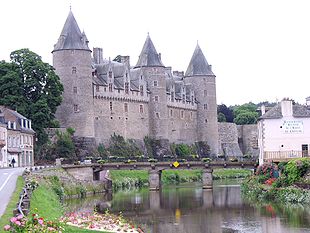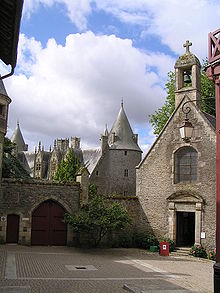- Josselin Castle
-
This article is about the medieval castle in Brittany, France. For the home of George and Sarah Joslyn in Omaha, USA, see Joslyn Castle.
 Josselin Castle and the River Oust
Josselin Castle and the River Oust
Josselin Castle (French: Château de Josselin, Breton: Kastell Josilin, Latin: Castellum Joscelini) is a medieval castle at Josselin, in the Morbihan department of Brittany, France, first built in the 11th century and rebuilt at various times since. It has been designated as a monument historique since 1928.[1]
Contents
History
Guéthénoc, vicomte of Porhoët, Rohan and Guéméné, began to build the first castle on the site around the year 1008, choosing a rocky promontory overlooking the valley of the Oust. The new fortress was named after Guéthénoc's son, Goscelinus.[2] The name is recorded in the Cartulary of Redon Abbey (1080) as castellum et castrum Goscelini,[3] but already by 1108 it was appearing as Castellum Joscelini.[4]
The site chosen for the castle was excellent from both the commercial and the military points of view, and since the 9th century there had also existed an annual pilgrimage in September to the Basilica of Our Lady of the Bramble (Notre-Dame du Roncier), which added greatly to the wealth of the lords and people of Josselin.
In 1154, Odo, Viscount of Porhoet, step-father, guardian and regent of the young Conan IV, Duke of Brittany, collected the Breton lords to deprive Conan of his inheritance, but was defeated by Henry II of England, who was also Duke of Anjou, whose protection Conan had sought. Henry married his fourth son, Geoffrey, to Conan's only child, Constance, Duchess of Brittany, and Henry and his son pulled Josselin Castle down in 1168 and 1175.[5] Henry II himself led the demolition and sowed salt into the ruins.
During the Breton War of Succession (1341–1364), the garrison of Josselin fought inconclusively the defenders of the nearby Castle of Ploërmel. To break the impasse, the Battle of the Thirty was arranged, contested by thirty knights from each side, and took place on 26 March 1351 half-way between the two places. The men of Josselin defeated the champions of Ploërmel, who consisted of four Bretons, six Germans, and twenty Englishmen.[6][7][8][9]
In 1370 the Breton soldier Olivier de Clisson (1336–1407), later Constable of France, acquired the lordship of Josselin and built an imposing new fortress with eight towers and a keep one hundred yards across.[2] He married his daughter Beatrice to Alain VIII of Rohan, heir to the viscounts of Rohan, whose own castle was not far away. The castle now boasts an equestrian statue of Olivier de Clisson.
In 1488 Francis II, Duke of Brittany, took the castle and partially demolished it. His daughter, Anne of Brittany, restored it to Jean II of Rohan, a great-grand-son of Olivier de Clisson, who transformed the property and built a noble new house with a fine granite facade, an early example of Renaissance architecture, importing Italian artists and artisans. In recognition of his patroness Anne, sovereign Duchess of Brittany and Queen Consort of France, Rohan added to the facade at several points the sculpted letter A beneath a cord, her badge.
Banned from Josselin due to their Protestantism, René II, Viscount of Rohan and the other Rohan men could not prevent the Duke of Mercœur, then Governor of Brittany, from turning their castle into a base for the Catholic League in its struggles against Henry IV of France.
In 1603, after being advanced by Henry IV to a dukedom, Henry, Duke of Rohan, one of the leaders of the insurgent Huguenots, transferred his military headquarters to his Castle of Pontivy. In 1629, Cardinal Richelieu dismantled the keep and four of the towers at Josselin and announced to Duke Henry: "My lord, into your game of skittles I have just thrown rather a good ball!"[10]
In the 18th century, the castle was no longer occupied as a seat of power, and during the years of the French Revolution and the First French Empire it became a prison and warehouse. In 1822, Caroline, Duchess of Berry, persuaded the then Duke of Rohan, Louis François de Rohan-Chabot, to restore it.
The Antechamber of the castle contains a marble bust of the 13th Duke, Alain Louis Auguste de Rohan-Chabot, sculpted in 1910 by Auguste Rodin.[11]
The Castle is still a residence of Josselin de Rohan, fourteenth Duke of Rohan, who was President of the region of Brittany from 1998 to 2004.[12][13]
Notes
- ^ http://www.culture.gouv.fr/public/mistral/merimee_fr?ACTION=CHERCHER&FIELD_1=REF&VALUE_1=PA00091310 Ministry of Culture data (French)
- ^ a b History at chateaujosselin.com, accessed 27 May 2010
- ^ A. de Courson (ed.), Cartul de l'abbaye de Redon
- ^ Victor Mortet, Recueil de textes relatifs l'histoire de l'architecture et à la condition des architectes en France au moyen age (2009 reprint) p. 199 online at books.google.co.uk, accessed 27 May 2010
- ^ Jean Ogée, Dictionnaire historique et géographique de la province de Bretagne (new edition by A. Marteville & P. Varin, vol. 1, 1843), p. 361 online at books.google.co.uk, accessed 27 May 2010
- ^ Steven Muhlberger, Deeds of Arms: Formal combats in the late fourteenth century (Highland Village, TX: The Chivalry Bookshelf, 2005), pp. 76-120
- ^ H. R. Brush, ed., 'La Bataille de trente Anglois et de trente Bretons', in Modern Philology, vol. 9 (1911-12) pp. 511-44; vol. 10 (1912-13) pp. 82-136
- ^ Andrew Sanger, Michelin the Green Guide France (2007), p. 280 online at books.google.co.uk, accessed 27 May 2010
- ^ Le Combat de Trente Bretons contre Trente Anglois (Paris: Jules Renouard, 1827 edition), p. 58 online, accessed 27 May 2010: "Ici finit la Bataille de trente Anglois et de trente Bretons, qui eut lieu en Bretagne l'an de grâce mil trois cent cinquante, le samedi avant Laetare Jerusalem."
- ^ «Monseigneur, je viens de jeter une bonne boule dans votre jeu de quilles!»
- ^ Welcome to the Castle... at chateaujosselin.com, accessed 27 May 2010
- ^ Le château de Josselin, une forteresse de Bretagne at photos-france.net, accessed 27 May 2010 (in French)
- ^ CHATEAU DE JOSSELIN (3 ha) at parcsetjardins.fr, accessed 27 May 2010
See also
External links
- Welcome to Josselin Castle - home page of official site
- Photographs of Josselin Castle at oositoo.com
- Josselin Castle at casteland.com
Categories:- Buildings and structures in Morbihan
- Fortified French châteaux
- Military history of Brittany
- Official historical monuments of France
Wikimedia Foundation. 2010.


